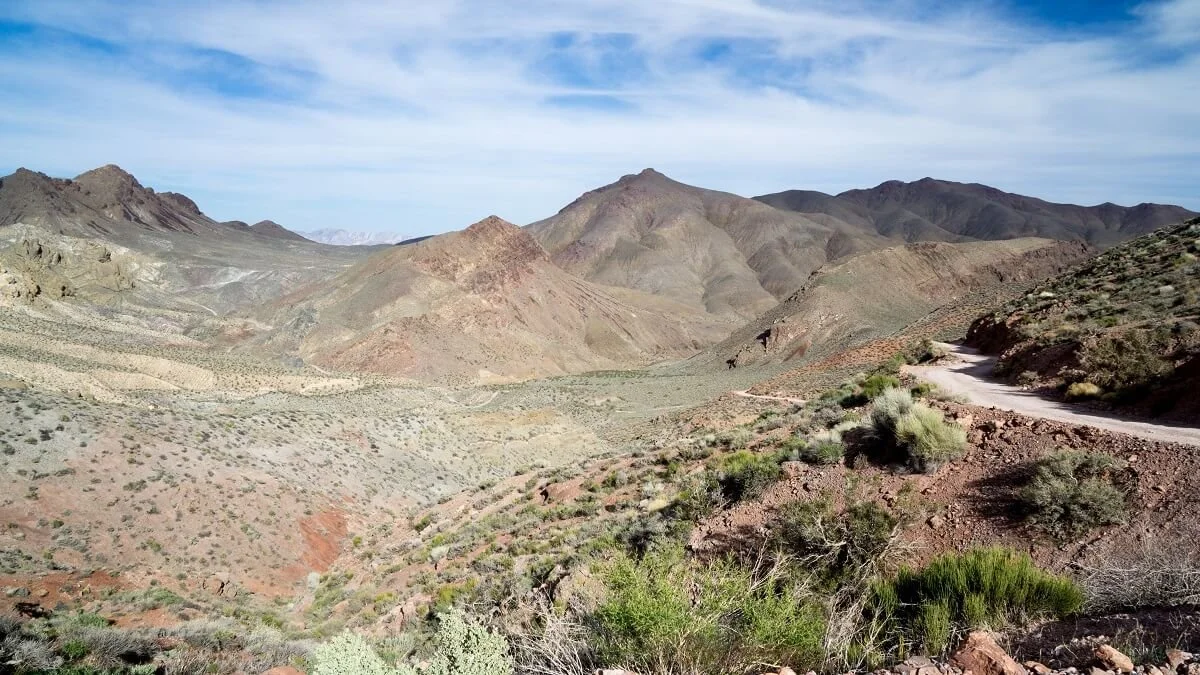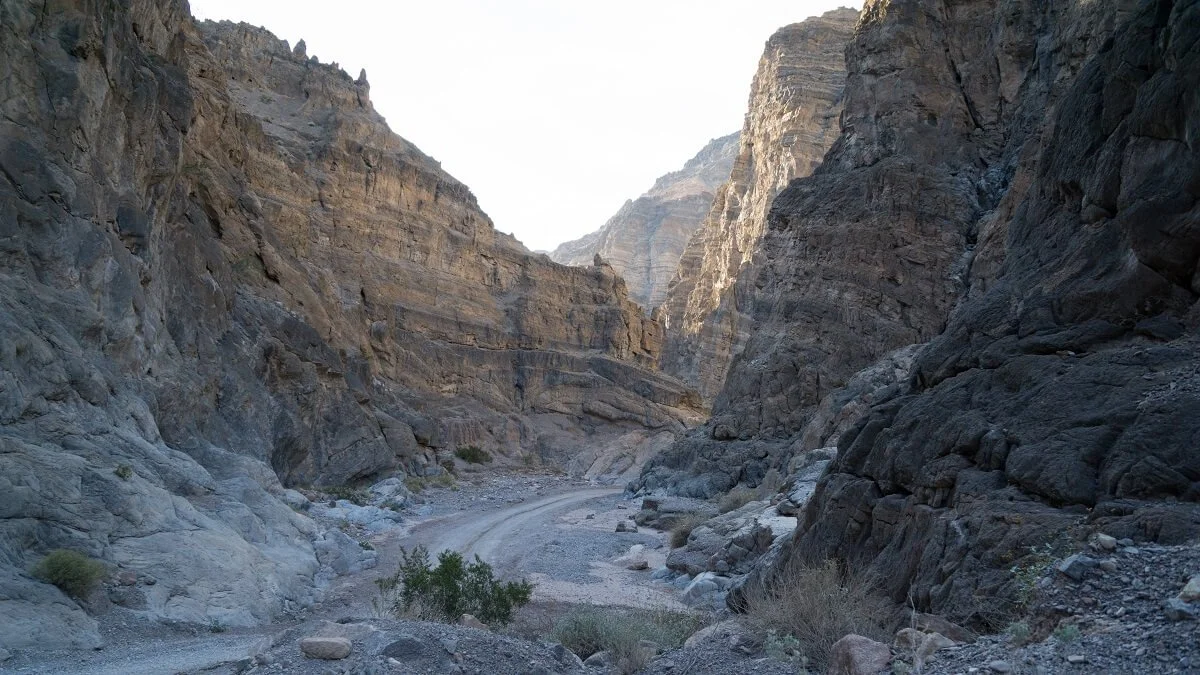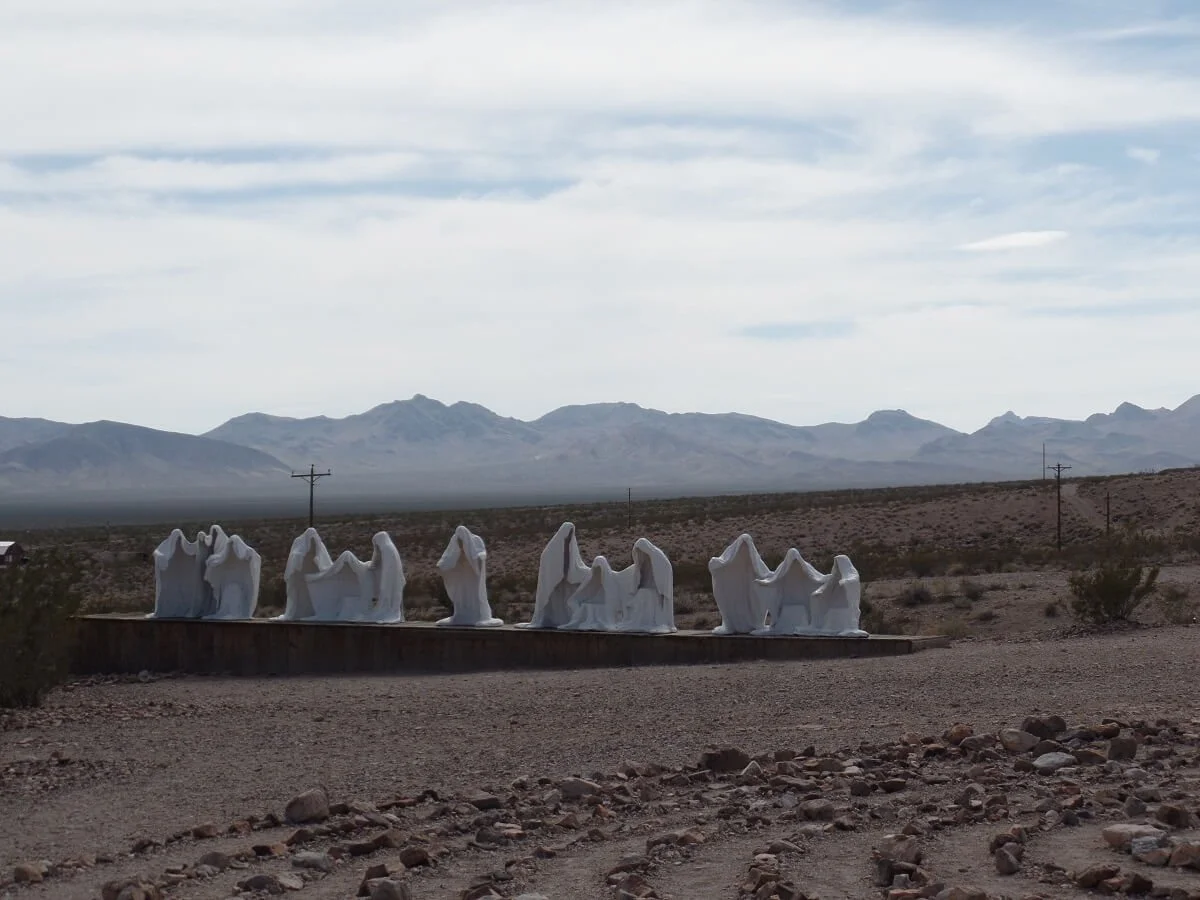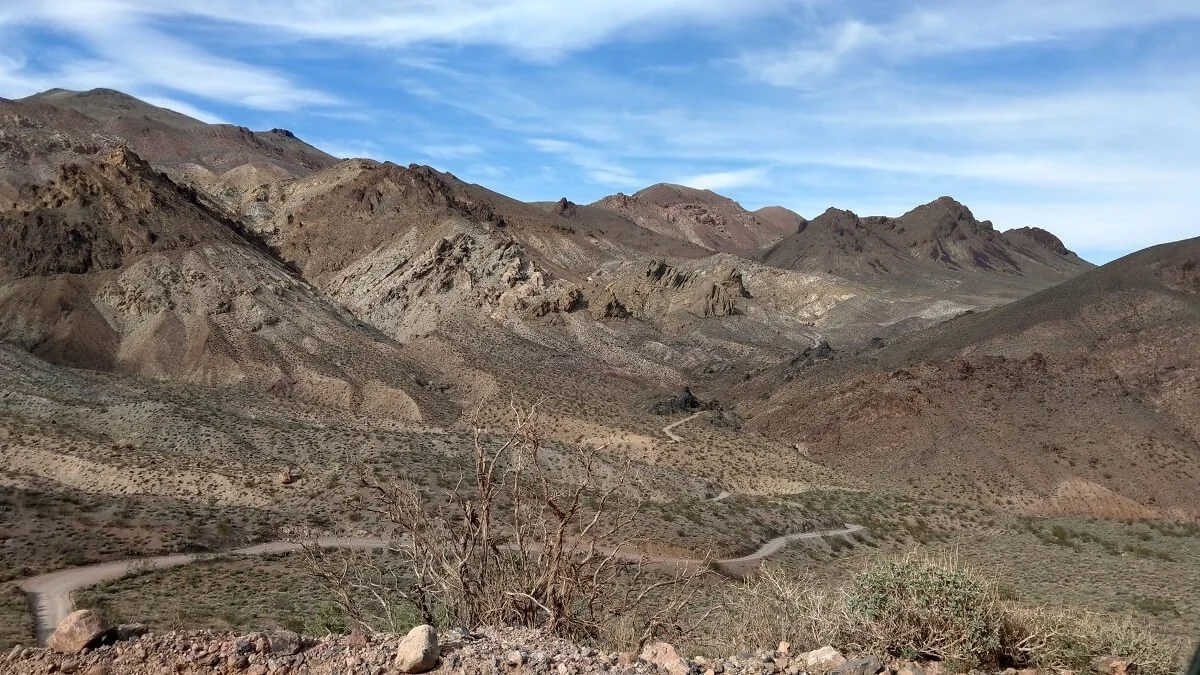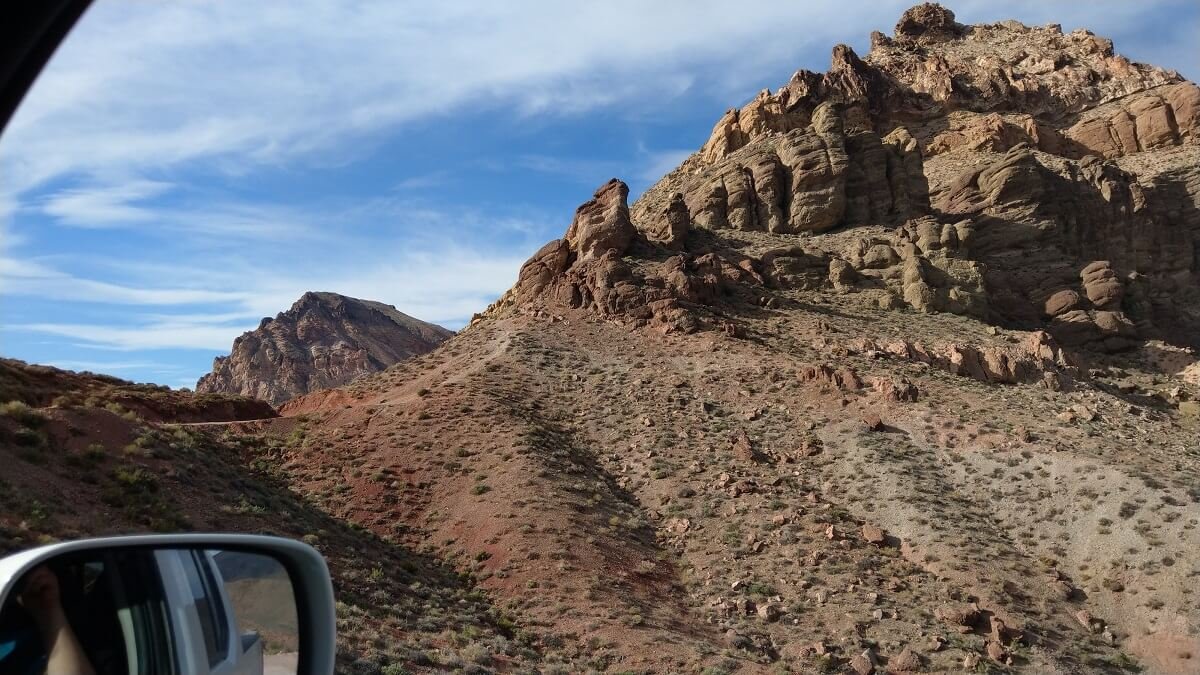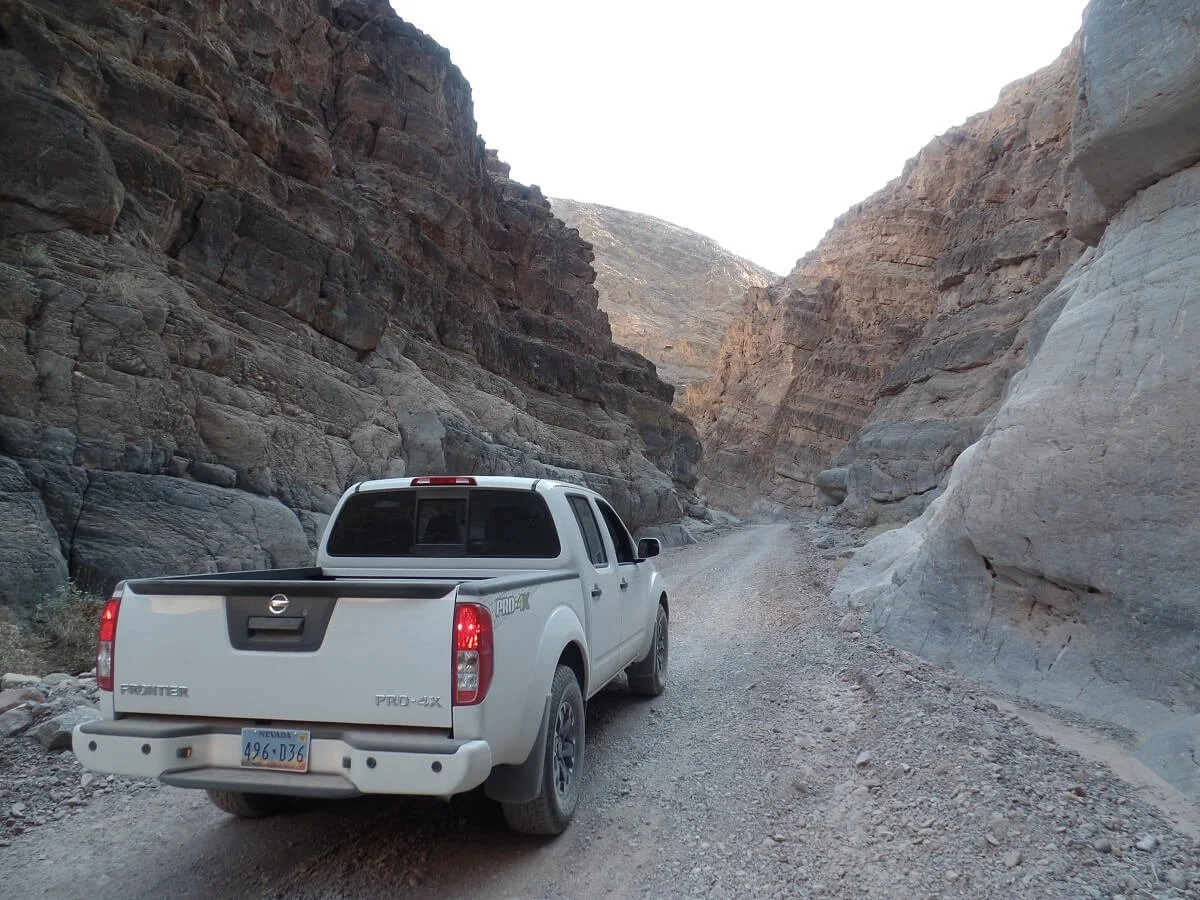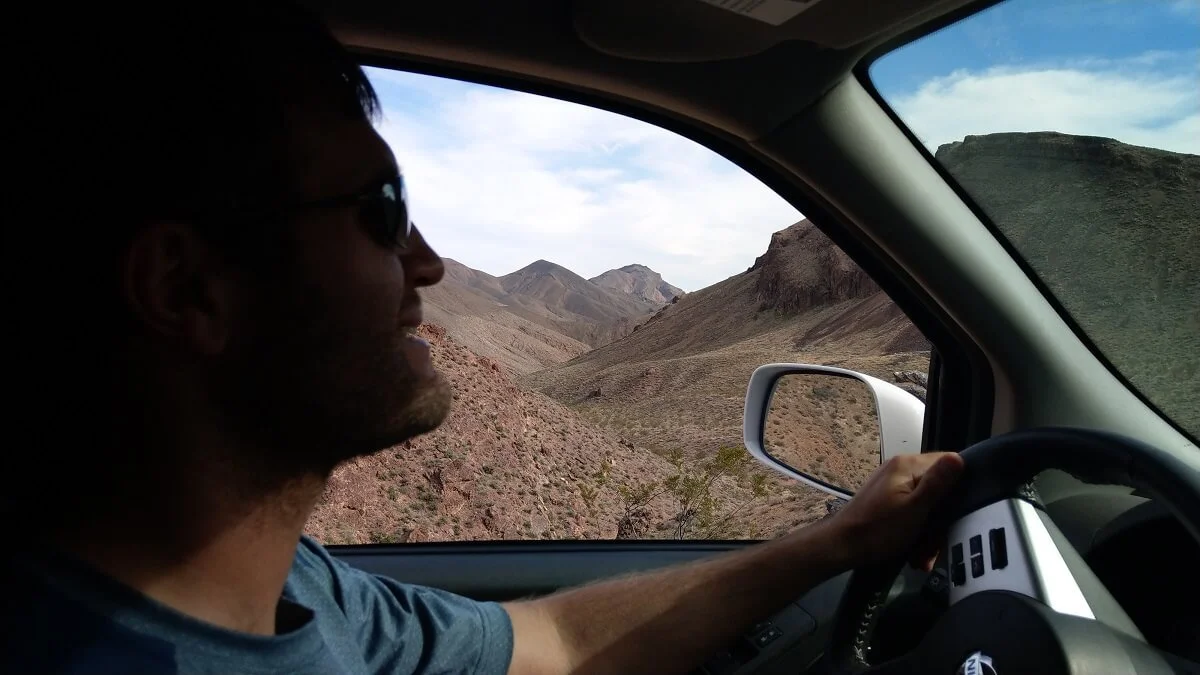The Ultimate Guide to Titus Canyon Road: The Best Scenic Drive in Death Valley!
Titus Canyon Road in Death Valley National Park is one of the best scenic drives we’ve ever done! Filled with stunning mountain passes, a ghost town, petroglyphs, and a huge canyon that you can drive through, Titus Canyon really has it all. In this guide, we’ll go over everything you need to know about how to complete the Titus Canyon scenic drive, from what type of vehicle you need, when to go, what to expect, and so much more.
Death Valley National Park is full of incredible scenery, and embarking on an epic scenic drive is one of the best ways to take it all in.
Titus Canyon Road is the king of all scenic drives in Death Valley. This 27 mile one-way backcountry road will take you over stunning mountain passes, by ghost towns, and between the towering walls of a narrow twisting canyon. Sounds pretty awesome, right?
We thought so! Actually, it was our favorite experience in our three days in Death Valley!
Titus Canyon Road blew away any expectations we had before coming to Death Valley. In fact, we weren’t initially even planning on doing it! We ended up making a super last minute decision on our last day in the park (i.e. we decided at 2:30pm to do it and we were on the road at 3pm that same day). I knew there was a cool canyon involved, but that’s really the only thing I could find about it. I had no idea what the rest of Titus Canyon Road would hold, and that there was this whole other part of the drive that would be absolutely breathtaking, yet nerve-wracking, all at the same time. Titus Canyon itself is just one small part of it, and arguably, it’s the entire rest of the journey to get to it that’s really what makes the Titus Canyon drive so special. It’s the ultimately backcountry adventure in Death Valley.
If this sounds like something you’d like to do in Death Valley, then stick around, because in this article, we’ll tell you everything you need to know to drive through Titus Canyon in Death Valley National Park. With its twisting mountain roads and desert-like conditions, this is one scenic drive you’ll want to make sure you’re well prepared for! We’ll tell you what kind of car you should have for Titus Canyon, the best time to drive it, how long it takes, what to expect, and more. So, let’s dive right in!
In this Titus Canyon Road guide:
15 Best Things to do in Death Valley
The Perfect One to Three Day Itinerary for Death Valley National Park
Titus Canyon Road: Why Was it Built?
Once you’ve seen what Titus Canyon Road is like and are able to marvel at how it winds its way through the Grapevine Mountains, one of the first questions that comes to mind is, why and how was this road even built? Turns out, it’s not just for us tourists to take in the scenery…
An area along the road, what is now a small ghost town named Leadfield, started becoming heavily mined in the early 20th century. A reportedly “crooked” promoter by the name of Charles Julian became president of the leading mining company here and lured in tons of investor money. The road was built in 1926 as way to get to these mines. Tons of people made the journey under the promise of lucrative and successful mining prospects, and the town of Leadfield was born.
Remnants of Leadfield along Titus Canyon Road in Death Valley
In the end, the mines produced extremely little, leading to the financial collapse of Charles and Leadfield itself less than a year after its establishment!
There’s plenty more to learn about the history of Leadfield and Titus Canyon Road, and you’ll dive headfirst into some of it on your journey into Titus Canyon. As you drive down Titus Canyon Road, you can see the remains of once was… small tin buildings and shacks, abandoned mines, and some old foundations.
How Long Does it Take to Drive Through Titus Canyon Road?
You’ll want to take your time on Titus Canyon Road to soak in all the scenery!
Titus Canyon Road is 30 miles. The first 27 miles is a one way backcountry road, and it’s a slow-going 27 miles.
The park service estimates the Titus Canyon drive will take 2-3 hours. In our experience, we felt we made pretty decent time. We didn’t stop to do any of the side hikes that you can do from the road, and we finished in 2.5 hours. I would say not to count on getting through much faster, or to even try. To make it in 2 hours, we think you would really have to be going a little too fast for comfort and that fast of a pace wouldn’t allow you to stop and really enjoy the scenery anywhere.
There are a couple of hikes on Titus Canyon Road that you can do while you’re out there:
Titanothere Canyon to Lostman Spring: 9 miles roundtrip
Thimble Peak: a 6 mile hike to a 6,381 foot peak in the Grapevine Mountains
Upper Titus Canyon: 5 miles roundtrip
If you want to include one of these into your day, expect the Titus Canyon drive to take closer to 6-7 hours, depending on how far you hike.
Do You Need A 4x4 or High Clearance Vehicle to Drive Through Titus Canyon Road?
The bumpy road conditions you’ll experience most of the way along Titus Canyon Road in Death Valley
The Titus Canyon Road is a rugged backcountry drive. The road is pretty rough and steep at times, with lots of narrow sections and tight turns. You absolutely need a high clearance vehicle to drive Titus Canyon Road. Having 4x4 or 4WD functionality would be ideal, and most likely necessary after any sort of inclement weather that may have damaged the road. When we talk about our experience driving through Titus Canyon below, you’ll see some of the more challenging sections of the road to give you a better idea of the road conditions.
When we drove Titus Canyon Road, we had good conditions and we never actually needed to use the 4x4 function on our vehicle, but it was comforting to know that we had it just in case. Getting stuck out in the middle of this road would be super problematic, as the road is not frequently patrolled, you might not have cell service, and it would take a while for any sort of tow truck or emergency vehicle to get to you. Better to be safe than sorry!
Can you visit Titus Canyon without a high clearance or 4x4 vehicle?
The good news is that even if you don’t have 4WD or high clearance, you can still see Titus Canyon! There is actually a way to see Titus Canyon without driving the entirety of the backcountry road.
The last three miles of Titus Canyon Road is a two way graded dirt road that’s okay for standard 2WD cars. This section of the road connects the west end of Titus Canyon with Scotty’s Castle Road (a main road through Death Valley). You can drive up this two way section from Scotty’s Castle Road and park your car just outside of the canyon’s exit. From here, you can hike right into Titus Canyon and see the narrowest and best parts of the canyon! Just be careful, as there will be lots of cars driving through from the other direction. The narrows of Titus Canyon last for about 1.5 miles, so an easy 3 mile hike is all that’s needed.
Whether you can drive the Titus Canyon Road or not, hiking through Titus Canyon is an awesome experience!
If you’re short on time or just don’t have the right vehicle to drive the whole road, then hiking into Titus Canyon like this is an amazing option. But if you’re able, we do highly recommend doing the entire Titus Canyon drive. The canyon itself is just one small part of an entire epic scenic drive, and the time and effort it take to complete it and drive over Red Pass is more than worth it, trust us!
Is Titus Canyon Road Dangerous?
Titus Canyon Road can be rough and steep. You’ll find yourself driving along narrow mountain roads that have some exposure and tight and turns as they switchback up to Red Pass. If you drive carefully, you should have no problems.
The narrow road heading up to Red Pass on Titus Canyon Road
If there are any obvious dangers to Titus Canyon Road, particularly from inclement weather and road washouts, the park will close the road until it’s safe. Be sure to check road status and road conditions before heading out.
I will say from personal experience that although Titus Canyon Road may not be entirely dangerous, it is a bit nervewracking. To those afraid of heights and cliffside roads (*raises hand*), this drive can be a little scary! You’ll be switchbacking up bumpy, narrow, dirt roads with a bit of exposure and no guard rails. Make sure you have a confident driver behind the wheel that won’t be terrified taking every hair pin turn. Luckily for me, Kevin is that driver! While I was in the passenger side simultaneously gripping my seat and somehow gawking and taking pictures of the epic scenery at the same time, Kevin was cool as a clam! But, I’m convinced that if I can do it, anyone can! The views and the whole experience were totally worth it.
Despite Kevin being unphased by the whole mountain road exposure thing, he does say as a driver that the Titus Canyon drive does just require a lot of focus and mental concentration, which made it a little exhausting to be behind the wheel. It’s several hours of really having to be aware of every bump and rock and dip in the road.
When Is The Best Time to Drive Titus Canyon Road?
Titus Canyon Road as it weaves its way between the tall rock walls of the canyon@
Titus Canyon Road is a rugged backcountry drive through the desert, so it’s important to know the best times to go.
The best time to visit Death Valley is between October to March. This is when the temperatures are a bit more tolerable- especially if you plan on doing one of the hikes on Titus Canyon Road. It will be safer to do so in this time frame when the midday temperatures aren’t as dangerously high.
Summer is a complete no-go for driving the Titus Canyon Road, not only because of the dangerous temperatures, but because if something does happen to you or your vehicle, help is far away. As we said above, the road is not well-patrolled by rangers and cell service may be unreliable. If you’re forced to walk the road to find help, you won’t want to do it in the summer heat. And if you end up stranded, again, you don’t want to be in sweltering temperatures. It’s also more likely there will be more people around in general on Titus Canyon Road in the fall, winter, and spring months which will give you more peace of mind in case you do have an emergency.
As far as time of day goes, we recommend starting the Titus Canyon drive early in the morning. Usually, we recommend trying to avoid the crowds, but not here. You’ll want to know there are people around, and as this is the most popular backcountry drive in Death Valley, there’s bound to be if you hit the road early.
Our experience was a bit different. We drove through Titus Canyon in April and we started very late in the day (3pm). Because of the combination of a late start and being late in the season, we did not see a single other person or vehicle anywhere during our entire drive! It made the experience absolutely amazing, but at the same time, looking back on it, if we had any sort of emergency or issue, I don’t know what we would have done. There would have been no one around for help. Starting in the morning means more people will be around you in case of an emergency, or, even if no one else is around, a morning start will give you much more time to try to find help or to fix any problems before dark.
Is Titus Canyon Road open?
Titus Canyon Road closes often due to inclement weather and washouts, so be sure to check the current road status before you head out.
Where Does Titus Canyon Road Start and End?
Since Titus Canyon Road is one way, everyone must start and end the drive the same.
Titus Canyon Road actually starts in Nevada! From Scotty’s castle Road in Death Valley, take Nevada Highway 374 (also called Daylight Pass Road) for 20 miles east up and over the Amargosa Mountains. If you’re coming from the east, the start of the road is just 6 miles west of the town of Beatty. The entrance to Titus Canyon Road is marked by a small sign that is easy to miss, so be on the lookout.
The ghostly figures of the Rhyolite Ghost town near Titus Canyon Road
You’ll exit Titus Canyon and drive the 3 mile two way portion of the road to rejoin Scotty’s Castle Road about 21 miles west of Beatty Junction.
Titus Canyon Road Map
Here is a map of where Titus Canyon Road starts and ends to help orient you a bit more.
Driving Titus Canyon Road: Our Experience and What to Expect
Since the drive on Titus Canyon Road can be a little bit more challenging than the average National Park scenic drive, we wanted to share our experience driving to Titus Canyon to help you decide if it’s something you want to tackle!
The Titus Canyon Road begins right off the bat on a rough and rugged road that actually made us question our last minute decision to check out this scenic drive in Death Valley. We really had no idea what to expect along this drive other than the famous narrows of Titus Canyon, but we knew that we were tired of bumpy wash-boarded roads. Well, for about the first 20 minutes, you’ll be traversing a long flat expanse of land via a bumpy, slow-going, and extremely wash-boarded dirt road as you head straight back towards the Grapevine mountain range. But don’t worry, it gets better…way better.
The long bumpy road at the start of the Titus Canyon drive in Death Valley
Eventually, you’ll reach the foothills of the Grapevine Mountains and start the ascent up the road, and the views start to become worth it. After a bit of uphill driving, you’ll reach a pass called White Pass where you can overlook Titanothere Canyon, an area known for its fossil beds that are dated up to 35 million years old. In fact, the canyon was named for a rhino-like creature whose fossil was found here.
At this point on Titus Canyon Road, you can find a hiking trail into Titanothere Canyon. Plan for a few hours if you want to hike!
We got out here to stretch our legs, half thinking we were already at Red Pass, the major mountain pass of the drive, and thinking that the drive actually wasn’t too bad. Obviously, I was wrong…very wrong! When we looked out into the distance, we saw the long weaving road switchbacking up into the mountains…it looked crazy! And we quickly realized that we had a long way to go. I was definitely not expecting such an adventure out of Titus Canyon Road, and I was getting a little bit nervous…this whole mountain drive leading up to the actual canyon was totally unexpected!
But there was no turning back from here, so we got back in the car and headed down the road. It weaved its way down to the base of the mountains through the surprisingly colorful hillsides and then began climbing back up the other side. This was where the scary part started… for me anyway! Kevin was having a blast.
As you traverse up the mountain, the road becomes exposed to the cliff edges and there are no guard rails. And of course, where the tight hairpin turns were at the end of each switchback was where the worst patches of road were, making things just a little more interesting, and bumpy. The turns were extremely rocky, even making the truck tilt to the side a bit.
A view from the car as you switchback up to Red Pass on Titus Canyon Road!
Despite being a bit harrowing, the scenery was absolutely amazing, and will distract you from any fear you might have. I was scared and in awe all at the same time. As you make your way up to Red Pass, you have an awesome view back into the mountains where you came from, and the colors up here are absolutely gorgeous!
These views along Titus Canyon Road were definitely worth it!
Looking over toward Red Pass along Titus Canyon Road
Red Pass is a tiny crest between two mountains. It’s the highest point on the road at 5,250 feet and divides the Titanothere and Titus Canyons. As the name suggests, it is very red!
We turned the corner to the top of Red Pass and the other side of the pass came into view. I’m pretty sure we just about had to pick our jaws up from the ground. It was a beautiful scene of mountains with a cool display of colors, and to our surprise, was very green. The contrast of the red and browns of Titanothere Canyon behind us and the greens of Titus Canyon and the rolling hills ahead of us was quite a sight.
Making the turn on the tiny Red Pass and looking towards Titus Canyon…it was so colorful up here!
Looking back through Titanothere Canyon…can you see the road weaving its way through the mountains?
We wish we took some more time here to get out of the car and enjoy the scenery, but the pass is really tiny, and as soon as you find yourself at the top, you’ll already be starting to head back down the other side. From Red Pass, you can take a hike up to Thimble Peak, which isn’t visible from the pass. The views of Death Valley are supposedly stunning from up there at 6300 feet above the valley floor, but requires an almost 6 mile roundtrip hike, so you’ll want to be sure to start early on Titus Canyon Road if this hike is on your radar.
But, onward, and downward, we went from here. We took a sharp left off the pass and started descending our first switchback down to the base of the mountains. My elation at reaching Red Pass quickly turned into panic as we made that turn…I won’t lie, it looked kind of terrifying, like we were just going to roll right off the edge! But, I took a deep breath, and cool as a clam Kevin continued the drive and it really was over before I knew it. Once we made that initial turn, it got way less frightening and you actually reach the bottom of the pass pretty quickly. And from here, it’s way more easy-going…no more passes and no more exposed cliffside roads. So give yourself a pat on the back…you made it through the hard part!
Looking down the road as we came off of Red Pass and started making our way to Titus Canyon
Towards the base of the mountain pass, we started seeing little mines here and there scattered in the hills and eventually came to Leadfield, the ghost town in the middle of the mountains. In the heart of it is a small pull off with some informational plaques where you can look at the few remaining shacks.
Definitely take some time to get out and explore while you drive Titus Canyon Road!
Soon after the ghost town, we reached the mouth of Titus Canyon. The high limestone walls gradually narrowed around us as we drove through the canyon wash. During your drive through the beginning portion of the Titus Canyon, there are two particularly tricky spots for the vehicle that are pictured below…at the springs, where the puddles are deceiving and actually quite deep, and just past the entrance to the canyon, where you must cross over a line of built up rocks. Like we said, having a high clearance vehicle is must and here’s why!
There are some tricky spots along Titus Canyon Road as you drive through the beginning portions of the canyon.
These “puddles” were deceptively deep!
The start of Titus Canyon was very cool to drive through as the canyon narrows and the walls grow higher. There are some particularly narrow sections that you have to squeeze your way through. You can get out any time to walk around and explore. There are even some hikes to do that are outlined in the brochure given by the Ranger Station that will allow you to explore the upper part of the canyon, but we didn’t have the time, or energy really, to do any.
You’ll also want to keep your eyes open for wildlife, particularly Bighorn Sheep. They are known to frequent the cliffsides, although we never spotted any. As you pass through Klare Springs, your chances of seeing Bighorn Sheep are greatest, as they depend on this water source. You can also find here old petroglyphs on the rocks.
Eventually, you’ll enter the Grand Finale of the drive, and the part you’ll typically see in pictures when you search for Titus Canyon in Death Valley…the Narrows!
The last one and a half miles are the narrows of the canyon, and even though the park service said that this part of Titus Canyon Road has the worst conditions of the entire drive, this was actually the best, smoothest section of road for us! (This could change, though, based on recent weather and condition so always look up the road status before you go.)
The road twisting between the high golden walls of Titus Canyon…so cool!
We loved this section of Titus Canyon Road! It’s fun to drive through the twists and turns of the canyon and squeeze your car through (the narrowest part of Titus Canyon is less than 20 feet wide!). And you can feel free to pull over on the wider sections to get out and enjoy the canyon on foot, which is fact recommended even by the park service to get the feel of the lighting, shadows, and echos of the canyon.
Titus Canyon Road gets pretty narrow as it twists between the high canyon walls
Enjoy your time in here, because it doesn’t take too much time until you make your final twist out of the canyon, and then down the last few miles of two- way road back to Scotty’s Castle Road. We were having so much fun that we were super disappointed that we were done!
Tips for Driving Titus Canyon Road in Death Valley
Overall, driving through Titus Canyon was an incredible backcountry road that we 100% recommend, but only with proper planning and mental readiness to tackle those twisty bumpy mountain switchbacks. Here are some extra tips to help you plan for the Titus Canyon drive.
Be prepared for anything. Have the supplies in your car to perform any minor repairs, such as a flat tires
Bring plenty of food and water. You’ll be out there for several hours or more, and you want to be prepared in case of any emergencies.
Visit a ranger station before you go. A ranger will give you lots of good advice about driving Titus Canyon Road, and you can snag an informational sheet that outlines the different milestones along the drive. You can also check in on weather and road conditions. Titus Canyon Road is usually closed after any sort of adverse weather.
Don’t go with rain in the forecast. As many canyons, Titus Canyon is susceptible to flash flooding, so id there’s any sort of the rain in the forecast in the area or nearby, don’t do the drive. The ranger can advise you on this as well.
Don’t drive Titus Canyon in the summer. We’ll say it again here. The summer is not a good time to embark on this drive, both for high temperatures and less people. If you’re here in the summer and really want to experience Titus Canyon, we suggest driving up to the exit of the canyon and walking in. Make sure to do this in the morning or evening hours and bring lots of water.
Know yourself. Study pictures and descriptions of the drive to make sure the road is something you can, and want, to handle. Remember, it’s a one way drive…there’s no turning back at any point!
Things to Do Near Titus Canyon in Death Valley National Park and Beyond
Want to check out more things to do nearby? Check out all of our guides of Death Valley, jam-packed with information that will help you plan your time!
Ultimate Guide to the Best Things To Do In Death Valley
The Perfect One to Three Day Death Valley Itinerary
How to Hike the Golden Canyon Gower Gulch Trail: Death Valley’s Best Hike!
And if you’re looking for other places in California to visit on a road trip, be sure to check these guides out to give you some travel inspiration:
The Best One Day in Joshua Tree National Park
How to Get a Permit to Hike Half Dome in Yosemite National Park
Think you’re ready to tackle the drive down Titus Canyon Road in Death Valley? We hope this guide gave you everything you need to know to plan your visit! Let us know in the comments if you have any questions about visiting Titus Canyon, we’d love to help!
